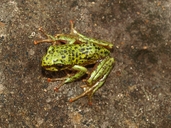|
Description
M 27-30 mm, F 33-42 mm. Tibiotarsal articulation reaches the eye. Hand with a trace of webbing, foot webbing 1(1), 2i(1), 2e(0.5), 3i(1.5), 3e(1), 4i/e(2), 5(1). Dorsal skin smooth. Males with unpigmented nuptial pads and a weakly distensible single subgular vocal sac. Dorsally green or light brown, with dark brown irregular markings, surrounded by light brown, that can form a vermiculated network. Females with a more vivid dark green colour. Discs of hands and feet and webbing orange. Iris metallic green.
Similar species: The green-vermiculated pattern is characteristic for this and the following species. The relationships of the the three taxa on this page are largely unclarified; they may be colour variants of one single species, but genetic differentiation among them has nevertheless been detected.
Distribution and Habitat
Country distribution from AmphibiaWeb's database: Madagascar
Ambalamarovandana, Ambatomenaloha, Ambohimitombo, Ambohitantely Andohariana plateau, Andrangoloaka, Ankafana, Col des Tapias, Itremo, Manjakatompo, Tsiafajavona plateau. It is observed between 1,400-2,400m asl. Boophis microtympanum inhabits scrubby forest on boulder and savannah areas at high altitudes, but not agricultural areas (Nussbaum et al. 2008).
Life History, Abundance, Activity, and Special Behaviors
This species inhabits open areas in the highlands of Madagascar, typically areas of savanna and ericoid vegetation along clear and relatively fast-flowing streams. These habitats can be at high elevations above the tree line, e.g., on the Ankaratra Massif, or in deforested areas at lower altitudes.
Calls: A series of 2-9 short notes, with one longer and one short, click-like note that can be arranged in different combinations. Males call at night. At high altitudes and low temperatures, they call from submerged positions in streams, at higher temperatures they sit on perches 0.5-1 m high along the streams.
It breeds in streams (Nussbaum et al. 2008) Trends and Threats
Least Concern in view of its relatively wide distribution, tolerance of a degree of habitat modification, presumed large population, and because it is unlikely to be declining fast enough to qualify for listing in a more threatened category. It occurs in the Andringitra and Ranomafana National Parks, and probably in other protected areas (Nussbaum et al. 2008).
Possible reasons for amphibian decline General habitat alteration and loss
Habitat modification from deforestation, or logging related activities
Intensified agriculture or grazing
Habitat fragmentation
Comments
Taken with permission from Glaw and Vences (2004) and Glaw and Vences (2007).
References
Glaw, F. and Vences, M. (1994). Amphibians and Reptiles of Madagascar. M. Vences and F. Glaw Verlags GbR., Köln.
Glaw, F., and Vences, M. (2007). Field Guide to the Amphibians and Reptiles of Madagascar. Third Edition. Vences and Glaw Verlag, Köln.
Nussbaum, R., Cadle, J., and Vallan, D. (2008). Boophis microtympanum. In: IUCN 2008. 2008 IUCN Red List of Threatened Species. www.iucnredlist.org. Downloaded on 07 April 2009.
Originally submitted by: Miguel Vences and Frank Glaw (first posted 2000-10-30)
Edited by: Henry Zhu (2009-05-05)Species Account Citation: AmphibiaWeb 2009 Boophis microtympanum <https://amphibiaweb.org/species/4353> University of California, Berkeley, CA, USA. Accessed Jun 12, 2025.
Feedback or comments about this page.
Citation: AmphibiaWeb. 2025. <https://amphibiaweb.org> University of California, Berkeley, CA, USA. Accessed 12 Jun 2025.
AmphibiaWeb's policy on data use.
|
